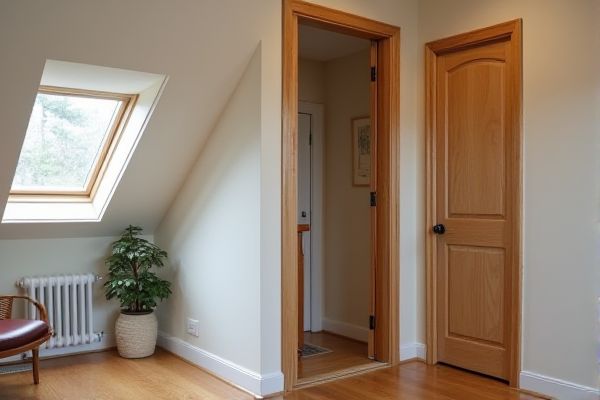
An attic lift offers a motorized platform designed to transport heavy items like boxes and furniture up to your attic, enhancing convenience and safety, while an attic dumbwaiter is a smaller, pulley-based system primarily used for moving lighter, smaller household items between floors. Explore the full article to understand which option fits your needs and how to optimize your attic storage solutions.
Table of Comparison
| Feature | Attic Lift | Attic Dumbwaiter |
|---|---|---|
| Purpose | Transport heavy items to attic | Transport small items or goods vertically |
| Capacity | Up to 500 lbs | Typically under 100 lbs |
| Size | Larger platform for bulky items | Compact, box-like compartment |
| Installation | Requires more space and structural support | Easier to install in small shafts |
| Operation | Motorized lift system | Motorized pulley or cable system |
| Cost | Higher initial cost ($3,000 - $7,000) | Lower to mid-range cost ($1,500 - $4,000) |
| Use Cases | Moving furniture, large boxes, heavy equipment | Transporting groceries, small boxes, meals |
| Maintenance | Regular motor and platform inspection | Routine cable and motor maintenance |
Introduction to Attic Lifts and Attic Dumbwaiters
Attic lifts and attic dumbwaiters are specialized devices designed to transport items between floors, specifically tailored for attic access. Attic lifts are motorized platforms that carry heavier loads and bulky items, providing efficient vertical transport with minimal physical effort. Your choice depends on the weight capacity and frequency of use, with attic dumbwaiters typically suited for lighter objects and smaller items.
Key Differences Between Attic Lifts and Dumbwaiters
Attic lifts are motorized platforms designed to transport large, heavy items like furniture or boxes to your attic with ease, while attic dumbwaiters are smaller, enclosed elevators primarily used for moving lightweight items such as groceries or laundry. Attic lifts typically provide higher load capacities and more spacious platforms, whereas dumbwaiters offer compact designs suitable for frequent, small-item transport. Choosing between the two depends on your need for weight capacity, size of items, and frequency of use in your home.
How Each System Works
An attic lift uses a motorized platform or small elevator that carries heavy items like furniture or boxes between floors, operated by switches or remote controls. An attic dumbwaiter consists of a small enclosed compartment or box that moves vertically within a hoistway, primarily designed for transporting smaller loads such as food, books, or tools. Both systems utilize pulley mechanisms and motors, but attic lifts handle larger, bulkier items while dumbwaiters focus on efficient, compact item transport.
Space and Structural Requirements
Attic lifts require minimal floor space and can be installed in compact areas, making them ideal for tight attics while necessitating strong ceiling joists for support. Attic dumbwaiters need a vertical shaft and more structural reinforcement to accommodate their hoisting mechanisms, often requiring more extensive space and construction modifications. Choosing between the two depends on attic size, load capacity, and the structural integrity of the installation site.
Installation Costs and Complexity
Attic lifts typically involve higher installation costs due to their motorized systems and reinforced structural requirements, averaging between $1,500 and $4,000 depending on home layout and lift capacity. Attic dumbwaiters, by contrast, usually incur lower installation expenses, often ranging from $800 to $2,500, as they rely on simpler pulley mechanisms and require less structural modification. Complexity in attic lift installation stems from electrical wiring and motor integration, whereas dumbwaiters involve basic hoisting systems, making them easier and faster to install in most residential settings.
Safety Features and Considerations
Attic lifts typically feature robust locking mechanisms and weight sensors to prevent overloading, enhancing user safety during operation. Attic dumbwaiters incorporate enclosed compartments and smooth-moving pulley systems to minimize the risk of items falling or jamming while in transit. Both devices require proper installation and regular maintenance to ensure optimal safety and compliance with building codes.
Weight Capacity and Usability
Attic lifts generally offer a higher weight capacity, often supporting loads up to 300 pounds, making them ideal for transporting heavier items like furniture or large storage bins. Attic dumbwaiters typically handle lighter loads around 50 to 150 pounds, suited for smaller objects such as boxes or groceries. Your choice depends largely on the type and frequency of items you plan to move, with attic lifts providing more robust usability for heavier, bulkier materials.
Maintenance and Longevity
An attic lift typically requires regular maintenance of its motor, cables, and pulleys to ensure smooth operation and extended lifespan, often involving periodic lubrication and professional inspections. In contrast, an attic dumbwaiter usually has fewer moving parts and simpler mechanical components, leading to lower maintenance demands and potentially longer longevity if used within its weight capacity. Choosing the right system depends on your expected usage frequency and willingness to perform routine care for optimal durability.
Best Use Cases for Each System
Attic lifts excel in transporting heavy, bulky items such as furniture and large storage bins directly between floors, making them ideal for renovations or moving heavy equipment. Attic dumbwaiters are best suited for lifting smaller, lighter loads like laundry, groceries, or small tools, enhancing convenience in multi-story homes or commercial settings. Selecting between the two depends on the weight capacity and frequency of use, with attic lifts offering robust solutions for heavy-duty needs while dumbwaiters provide efficient, space-saving transport for everyday items.
Choosing the Right Solution for Your Home
Selecting the right attic lift or attic dumbwaiter depends on your home's layout and lifting needs. An attic lift is ideal for transporting heavier, bulkier items due to its robust motor and platform design, while an attic dumbwaiter suits smaller loads like groceries or tools with its compact, enclosed carriage. Consider your storage requirements, weight capacity, and ease of installation to ensure your chosen system enhances your home's functionality efficiently.
 homyna.com
homyna.com